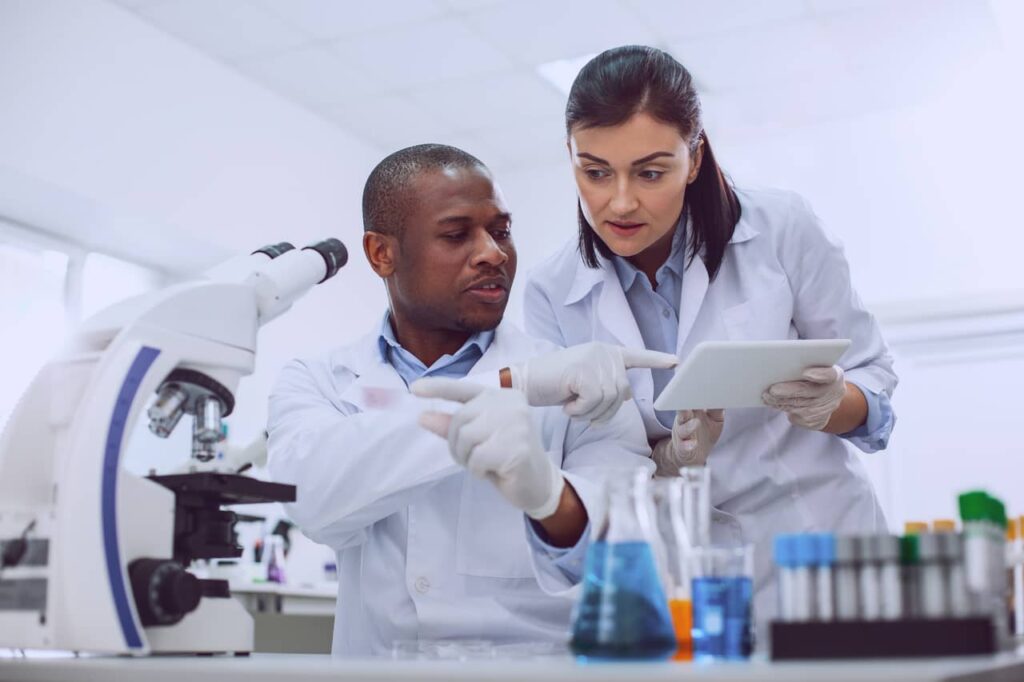Genetics and its principles governs the biological phenomenon of heredity, or the transmission of characteristics from parents to child via information encoded biochemically using DNA in units called genes.
Genetic variations are differences in portions of genetics information at the same genomic site between individuals, with the size of the differences ranging from small single nucleotide changes to differences spanning entire chromosomes. Mendel’s research laid the groundwork for scientists to calculate the probabilities of genotypes and phenotypes in the offspring of genetics cross.
However, Mendelian genetics cannot explain or predict all genetics observation. Other complex and unique genetic phenomena are possible. Several complex concepts of genetics, which are discussed in this section, explain genetics phenomena such as blood types and skin color.
Incomplete Dominance Genetics
Dominance does not exist in some allele combinations. Instead, the two characteristics are expressed in equal measure. Snapdragon flowers, for example, have a color dominance that isn’t complete. Flower color is determined by two alleles: one for white and one for red. When two white alleles are present, the plant produces white flowers. The plant has red flowers when two alleles for red are present. Snapdragons, on the other hand, are pink when one allele for red and one allele for white are present. When two pink snapdragons are crossed, the offspring have one red, two pink, and one white phenotype ratio. These findings show that the genes themselves are unaffected; only their expressions appear to blend. Pure red and pure white snapdragons could not exist in the offspring if the red and white genes actually blended.
Multiple Alleles
There may be more than two alleles for a given trait in some cases. Even if an individual only has two alleles, the population may contain additional alleles. Multiple alleles is the term for this condition.
An example of multiple alleles is blood type.
Blood groups in humans are determined by a single gene with three alleles: A, B, or O. Antigens A and B can be found in red blood cells.
A, B, AB, and O blood types are determined by the presence or absence of these antigens.
- The blood type of a person is determined by the presence of antigens A & B in their red blood cells.

- The blood type AB is determined by the presence of both antigen A and antigen B in red blood cells.
- The blood type O is defined as having neither antigen A nor antigen B in the red blood cells.
- Type A and type B blood alleles are codominant, which means that both alleles are expressed.
- The allele for type O blood, on the other hand, is recessive to both type A and type B blood.
Because only two of the three alleles are present in each person, the blood type varies depending on which two alleles are present. A person with the A allele and the B allele, for example, has the blood type AB. The blood type A is determined by having two A alleles or one A and one O allele. A person’s blood type is B if they have two B alleles or one B and one O allele. A person’s blood type is O if they have two O alleles.
Polygenic Inheritance
Although alleles at a single location on the chromosome determine many characteristics, others are determined by the interaction of genes on multiple chromosomes or at multiple locations on a single chromosome. This condition is inherited in a polygenic manner. Human skin color is an exemplar of polygenic inheritance.

Skin color is determined by which genes are present in multiple locations, and skin color is determined by which genes are present in multiple locations. A person with a lot of genes for dark skin will have dark skin, and someone with a lot of genes for light skin will have light skin. Many people have genes for light and dark skin, which explains why there are so many different shades of skin. Another trait that is likely to reflect polygenic characteristics is height.
Gene Linkage
A chromosome contains thousands of genes; the human genome contains an estimated 20,000 genes. Inheritance is the process by which chromosomes are transferred from parent to offspring via meiosis and sexual reproduction. If several genes are located on the same chromosome, they are likely to be inherited together. A linkage group is made up of genes that are inherited together. Gene linkage is the concept of transferring a linkage group.

The proximity of two or more genes on a chromosome can be determined by gene linkage. The more closely related the genes are, the more likely they will be inherited together. Crossing over happens during meiosis, but genes that are close to each other tend to stay together.
Sex Linkage
The sex chromosomes are one of the 23 pairs of chromosomes in human cells. (The remaining 22 chromosome pairs are known as autosomes.) Human sex is determined by the sex chromosomes. The X chromosome and the Y chromosome are the two types of sex chromosomes. Female species have two X chromosomes, while male species have one X and one Y chromosome. The female chromosome pattern is usually denoted as XX, while the male chromosome pattern is denoted as XY.
Thus, the human male’s genotype is 44 XY, while the human female’s genotype is 44 XX (where 44 represents the autosomes). The Y chromosome is much shorter in humans than the X chromosome. A number of sex-related conditions occur as a result of this reduced size. When one gene is found on one X chromosome, the other gene in the pair is most likely found on the other X chromosome.

As a result, a female usually has two genes for each trait. When a gene occurs on an X chromosome in a male, there is usually no other gene on the short Y chromosome. As a result, whatever gene is present on the X chromosome will be expressed in males. An example of a sex-linked characteristic is color blindness. A gene on the X chromosome causes color-blindness. A woman is rarely colour-blind because one of her X chromosomes usually carries a dominant gene for normal vision. A male, on the other hand, has a shortened Y chromosome and thus no gene to offset a colour-blindness gene on the X chromosome.
As a result, the male gene for colour-blindness expresses itself. Genes have an impact on both physical and psychological traits. In the end, the interaction between our genes and our environments determines how and when a gene is expressed, as well as the outcome (both physical and psychological characteristics).
Further Reading:









